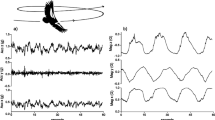Abstract
The current global population growth has intensified the demand for feed, especially dairy and meat products. In response to this growing need, precision livestock farming has become essential to manage animals efficiently and sustainably. Within this new approach, individual monitoring of each animal is essential. To this end, activity monitoring collars have been postulated as one of the most valuable tools for this purpose. With this in mind, three dimensional reduction methods (ICA, Isomap and t-SNE) have been analyzed in this study to identify patterns in the daily behavior of dairy cows through data collected by these collars. T-SNE was found to be especially effective in distinguishing individual or small group behaviors of animals, which is crucial for improving herd management and early detection of health or behavioral problems.
Access this chapter
Tax calculation will be finalised at checkout
Purchases are for personal use only
Similar content being viewed by others
References
Innogando. (2023). https://innogando.com/. Accessed 19 Dec 2023
Berckmans, D.: General introduction to precision livestock farming. Anim. Front. 7(1), 6–11 (2017)
Chaudhry, A.A., Mumtaz, R., Zaidi, S.M.H., Tahir, M.A., School, S.H.M.: Internet of Things (IoT) and machine learning (ML) enabled livestock monitoring. In: 2020 IEEE 17th International Conference on Smart Communities: Improving Quality of Life Using ICT, IoT and AI (HONET), pp. 151–155. IEEE (2020)
Fukase, E., Martin, W.: Economic growth, convergence, and world food demand and supply. World Dev. 132, 104954 (2020)
Garcia, R., Aguilar, J., Toro, M., Pinto, A., Rodriguez, P.: A systematic literature review on the use of machine learning in precision livestock farming. Comput. Electron. Agric. 179, 105826 (2020)
Geng, X., Zhan, D.C., Zhou, Z.H.: Supervised nonlinear dimensionality reduction for visualization and classification. IEEE Trans. Syst. Man Cybernet. Part B (Cybernetics) 35(6), 1098–1107 (2005)
Ghojogh, B., Ghodsi, A., Karray, F., Crowley, M.: Multidimensional scaling, Sammon mapping, and Isomap: tutorial and survey. arXiv preprint arXiv:2009.08136 (2020)
Halachmi, I., Guarino, M., Bewley, J., Pastell, M.: Smart animal agriculture: application of real-time sensors to improve animal well-being and production. Annu. Rev. Animal Biosci. 7, 403–425 (2019)
Handcock, R.N., et al.: Monitoring animal behaviour and environmental interactions using wireless sensor networks, GPS collars and satellite remote sensing. Sensors 9(05), 3586–3603 (2009)
Ji, S., Zhang, Z., Ying, S., Wang, L., Zhao, X., Gao, Y.: Kullback-Leibler divergence metric learning. IEEE Trans. Cybernet. 52(4), 2047–2058 (2020)
Van der Maaten, L., Hinton, G.: Visualizing data using t-sne. J. Mach. Learn. Res. 9(11) (2008)
Michelena, Á., et al.: Beta Hebbian learning for intrusion detection in networks with MQTT protocols for IoT devices. Logic J. IGPL 32(2), 352–365 (2024)
Neethirajan, S.: The role of sensors, big data and machine learning in modern animal farming. Sens. Bio-Sens. Res. 29, 100367 (2020). https://doi.org/10.1016/j.sbsr.2020.100367
Riaboff, L., Shalloo, L., Smeaton, A.F., Couvreur, S., Madouasse, A., Keane, M.T.: Predicting livestock behaviour using accelerometers: a systematic review of processing techniques for ruminant behaviour prediction from raw accelerometer data. Comput. Electron. Agric. 192, 106610 (2022)
Stone, J.V.: Independent component analysis: a tutorial introduction (2004)
Stygar, A.H., et al.: A systematic review on commercially available and validated sensor technologies for welfare assessment of dairy cattle. Front. Veterin. Sci. 8, 634338 (2021)
Tenenbaum, J.B., Silva, V.D., Langford, J.C.: A global geometric framework for nonlinear dimensionality reduction. Science 290(5500), 2319–2323 (2000)
Tharwat, A.: Independent component analysis: an introduction. Appl. Comput. Inform. 17(2), 222–249 (2021)
Thornton, P.K.: Livestock production: recent trends, future prospects. Philos. Trans. Roy. Soc. B: Biol. Sci. 365(1554), 2853–2867 (2010)
Acknowledgements
Álvaro Michelena’s research was supported by the Spanish Ministry of Universities (https://www.universidades.gob.es/), under the “Formación de Profesorado Universitario” grant with reference: FPU21/00932.
CITIC, as a center accredited for excellence within the Galician University System and a member of the CIGUS Network, receives subsidies from the Department of Education, Science, Universities, and Vocational Training of the Xunta de Galicia. Additionally, it is co-financed by the EU through the FEDER Galicia 2021-27 operational program (Ref. ED431G 2023/01).
This work has been supported by Centro Mixto de Investigación UDC-NAVANTIA (IN853C 2022/01), funded by GAIN (Xunta de Galicia) and ERDF Galicia 2021-2027.
Antonio Díaz-Longueira’s research was supported by the Xunta de Galicia (Regional Government of Galicia) through grants to Ph.D. (http://gain.xunta.gal), under the “Axudas á etapa predoutoral” grant with reference: ED481A-2023-072.
Xunta de Galicia. Grants for the consolidation and structuring of competitive research units, GPC (ED431B 2023/49).
Author information
Authors and Affiliations
Corresponding author
Editor information
Editors and Affiliations
Rights and permissions
Copyright information
© 2024 The Author(s), under exclusive license to Springer Nature Switzerland AG
About this paper
Cite this paper
Michelena, Á., Díaz-Longueira, A., Arcano-Bea, P., Quintián, H., Fontenla-Romero, Ó., Calvo-Rolle, J.L. (2024). Dimensional Reduction Techniques for the Characterization of Behavioral Patterns in Dairy Cows. In: Zayas-Gato, F., Díaz-Longueira, A., Casteleiro-Roca, JL., Jove, E. (eds) Distributed Computing and Artificial Intelligence, Special Sessions III - Intelligent Systems Applications, 21st International Conference. DCAI 2024. Lecture Notes in Networks and Systems, vol 1173. Springer, Cham. https://doi.org/10.1007/978-3-031-73910-1_4
Download citation
DOI: https://doi.org/10.1007/978-3-031-73910-1_4
Published:
Publisher Name: Springer, Cham
Print ISBN: 978-3-031-73909-5
Online ISBN: 978-3-031-73910-1
eBook Packages: Intelligent Technologies and RoboticsIntelligent Technologies and Robotics (R0)




